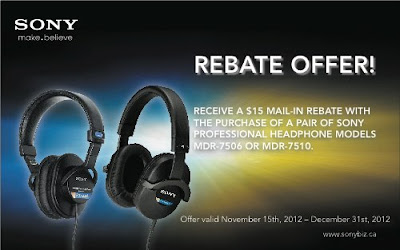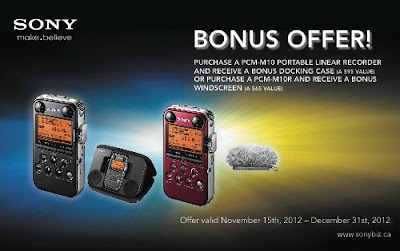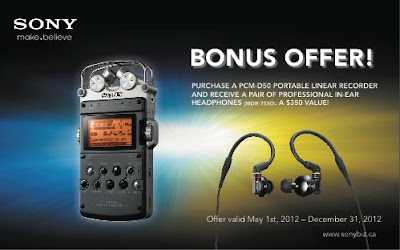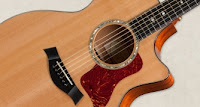Great news from Radial Engineering! Every Primacoustic VoxGuard Vocal Isolator now includes a free set of TriPad Mic Stand Isolators.
Buy VoxGuard in the Revolution Audio online store.
Here you will find home recording news, tips and articles as well as reviews of new recording gear and software. Revolution Audio Canada exists to spark the home studio uprising by any means possible!
11.27.2012
11.26.2012
Sony Pro Audio mail-in rebates
From now to the end of the year Sony is running some great mail-in bonus offers to users.



- Buy a PCM-D50 and get a free set of MDR-7750 in-ear headphones ($350 value).
download rebate form (pdf) - Buy a PCM-M10 and get a free docking case ($95 value).
download rebate form (pdf) - Buy a PCM-M10R (red) and get a free wind filter ($65 value).
download rebate form (pdf) - Get $15 back after buying MDR-7506 or MDR-7510 professional headphones
download rebate form (pdf)



Labels:
bonus,
free,
Headphones,
mail-in rebate,
portable recorder,
sale,
sony
11.02.2012
Featured Equipment: Samson Airline Micro Camera Wireless lav mic set
Samson Airline Micro Camera Wireless lav mic set
The AirLine Micro Wireless Camera System utilizes the latest in lithium-ion battery technology and high-quality audio and RF components, representing a breakthrough that is ideal for all video camera applications requiring outstanding audio, including DSLR video. The result is our smallest wireless system ever.
To eliminate continually changing batteries, Samson has designed this wireless system to be fully rechargeable with lithium-ion batteries for both the AL2 transmitter and AR2 receiver. The AR2DT double-docking station provides power to both units via a USB DC input, as well as a 3.5mm balanced audio output for the receiver. With AirLine Micro, the days of replacing batteries in your wireless camera system are over.
Find out more: Samson Airline Micro Camera
 TOP FEATURES
TOP FEATURES
AirLine Micro Wireless Camera System
The AirLine Micro Wireless Camera System utilizes the latest in lithium-ion battery technology and high-quality audio and RF components, representing a breakthrough that is ideal for all video camera applications requiring outstanding audio, including DSLR video. The result is our smallest wireless system ever.
To eliminate continually changing batteries, Samson has designed this wireless system to be fully rechargeable with lithium-ion batteries for both the AL2 transmitter and AR2 receiver. The AR2DT double-docking station provides power to both units via a USB DC input, as well as a 3.5mm balanced audio output for the receiver. With AirLine Micro, the days of replacing batteries in your wireless camera system are over.
Find out more: Samson Airline Micro Camera

AirLine Micro Wireless Camera System
- Wireless system with micro-sized AL2 transmitter, AR2 receiver and double dock
- Tone squelch and auto mute for clear operation
- Includes a system carry case, hot shoe mount, 3.5mm and XLR camera connectors, AC adapter and charging cables
- Beltpack transmitter and LM10 omnidirectional lavalier microphone
- Lithium-ion rechargeable battery (7-8 hours of operation)
- USB DC input for recharging
- Single button operation for power, mute and volume
- Multi-color LED displaying RF, low battery and power
- Low-profile wireless receiver (2.36” x 1.67” x .51”)
- Lithium-ion rechargeable battery (7-8 hours of operation)
- USB DC input for power and recharging
- 3.5mm balanced mic/line level output
- Multi-color LED displaying RF, low battery and power
- Provides secure base for AL2 transmitter during recharging and AR2 receiver during operation and/or recharging
- USB DC input for power and recharging (cables included)
- 3.5mm unbalanced audio output
Mixing Acoustic Guitars
Acoustic guitars are one of the most dynamic and expressive instruments used in modern music. They have a broad frequency range covering almost the entire audible spectrum. The instrument can serve many different roles in an arrangement as a harmonic, melodic, or percussive element. All of these factors will affect how you approach both the recording and mixing acoustic guitars.
 Context
ContextThe first thing to do is think about its role in the song/mix. Is the guitar the main harmonic instrument? Is it supposed to enhance or thicken other harmonic instruments like electric guitars? Is it enhancing the melody, playing arpeggios or single notes? Is it a percussive element more like a shaker just to fill out the rhythm section? Figure out the goal, then you can begin processing.
Tone control
Depending on the guitar, microphone, pick, player and role in the arrangement, acoustic guitars always require at least a little equalization to fit in a mix. Cutting of nonmusical sub frequencies (everything below 100Hz) is a must. A low shelf may be required to tame the remaining low-end. In the midrange, take out any unflattering frequencies causing 'boxiness' or anything that might mask the vocals. A broad, gentle high shelf boost can enhance articulation and an overall more sparkly sound. The general strategy is to remove what you don't need, then enhance what you do.
Dynamics
An acoustic guitar performance is often extremely dynamic, which is often a problem. A compressor will even out the differences between loud and soft notes and help keep the level more constant throughout the track. It's easy to take it too far, so keep the gain reduction to no more than 3-4dB. The compressor's attack control will allow you to clamp down on the beginning of the notes, or when set slower (about 20-50ms) will enhance the transient which helps it stand out more in the mix.
At this point you may want to adjust the sound envelope further though use of a transient shaper. This tool can increase or decrease pick attack, and separately adjust sustain.
Depth
Sending your acoustic track(s) into a stereo reverb will add space and distance to the sound. The trick here is to not wash out the sound in a ton of reverb, but just to move the move the mics back a bit into an imaginary room. Usually, a short room type verb with the highs rolled off is the best bet. Try to make the reverb sound like an office or large bedroom - short decay with and a bit of early reflections. The predelay control will separate your source from the room.
Summary
And so, following the above strategy you should now have an acoustic guitar track with a balanced frequency response, even dynamics and sense of space around the instrument, (if that was what the track required). The track is ready to be put in the mix with the other instruments. Tweak the EQ in context with the other tracks, adjust the reverb send amount, and even EQ the reverb if needed.
Examples
Acoustic Raw
Acoustic Processed
Subscribe to:
Posts (Atom)

